Introduction

Some of you may still remember the first part of this series, where I described what analogue cameras I had a look at and why I ultimately ended up with a Leica M6. An F-mount analogue camera was also in strong consideration, but I did not go for it because I did not want to buy a set of F-mount lenses – and the F-mount being a dead mount anyway. But in the meantime some things have changed, so here I am again…
F-mount Lenses in 2024
The Nikon F-mount was around for a very long time (1959 to 2018), as unlike Canon (FD-mount 1971 to 1990) and Minolta (SR from 1959 to 1984), Nikon kept their mount when making the transition from manual focus to auto focus. This means a wider variety of lenses is avaliable for the F-mount and many lenses released in the 2000s still work flawlessly on the older analogue cameras.
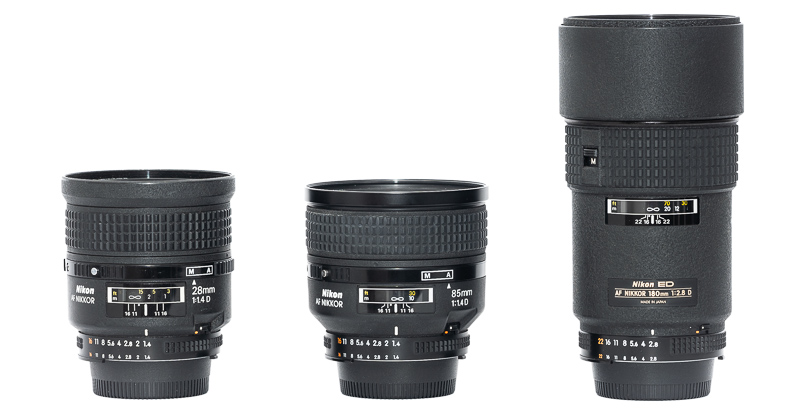
As Nikon decided to only release an F-to-Z adapter that does not allow the screw-driven auto focus of the older F-mount lenses to work on their Z-mount mirrorless cameras, their prices on the used market dropped quite a bit lately. Now interestingly in early 2024 Monster released an adapter that allows this screwdrive AF to work on Sony cameras. These two aspects lead to me acquiring a few of those AF-D lenses (Nikon AF-D 28mm 1.4, Nikon AF-D 85mm 1.4, Nikon AF-D 180mm 2.8).

Another interesting development was Cosina’s release of a new F-mount lens, the Voigtländer 55mm 1.2 SLII-S, in early 2023. I certainly did not see that coming, but it shows, that the F-mount might not be as dead after all. Currently (2024) Cosina still offers a line up of five interesting modern manual focus lenses for the F-mount under the Voigtländer brand.
Which camera to get?
Because the F-mount was in use for so long, also the amount of film cameras to choose from is staggering and I cannot possibly talk about all of them, so I will tell you which series I personally think are most interesting these days.
F80, F100, F5 and F6
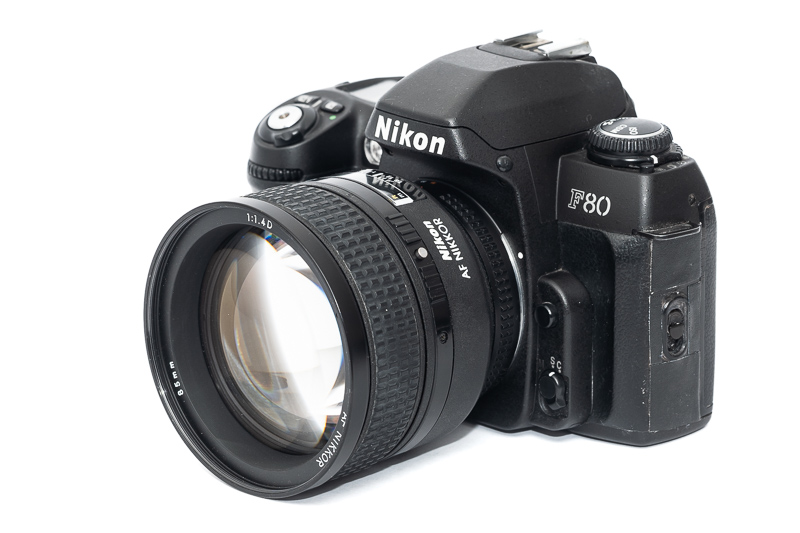
These AF cameras offer the highest compatibility to modern lenses, as they support G lenses without aperture ring and even the in lens VR works (the latest E lenses with electronically controlled diaphragm do not work though).
The problem with the F80 and F100 is that these cameras use some disgusting rubber coating similar to the finish of the Sigma Zen series lenses. This gets sticky over time and there is not a lot that you can do about it.
The F80 and F100 also come with focusing screens without a split prism, so out of the box they may not be the best choice if you want to mainly use manual focus lenses. The F80 also needs lenses with a CPU for metering to work.
From this category I have a Nikon F80, as it is the cheapest and lightest film camera that can make use of the AF-S G VR lenses.
Find an F80 starting at $60 on ebay.com (affiliate link)
Find an F100 starting at $180 on ebay.com (affiliate link)
Find an F5 starting at $280 on ebay.com (affiliate link)
Find an F6 starting at $900 on ebay.com (affiliate link)
FM and FE Series
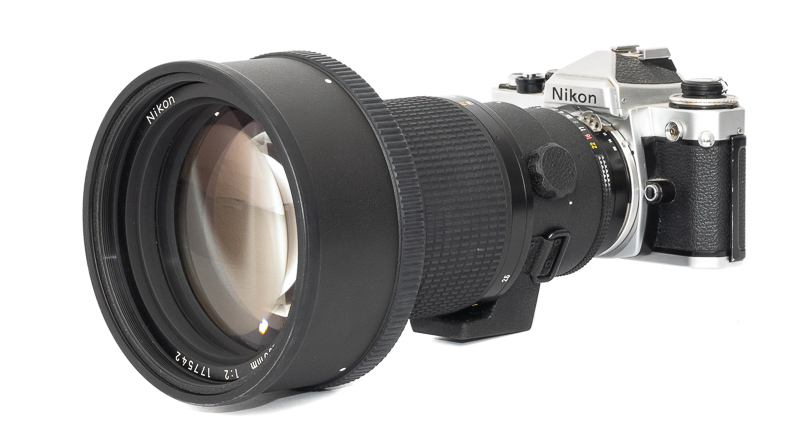
If you already know about the differences between the Leica cameras M6 and M7 we could say that the FM is Nikon’s M6 and the FE is Nikon’s M7.
The FM and FM2 are purely mechanical cameras except for the exposure meter. The FE and FE2 feature an electronic shutter and an aperture priority mode.
The FM3a is a really special camera, as it combines the best of both worlds: it has an electronic shutter and aperture priority mode, but if you ever run out of battery it is a fully usable mechanical camera like the FM2.
These cameras work with all the manual focus Ai(-s) lenses, so they are fully compatible to manual focus lenses made since 1977 and earlier ones that have been modified to Ai.
They also work with modern AF lenses in manual focus mode, as long as they feature an aperture ring (this means you can not use the latest G and E lenses).
These cameras come with focusing screens that feature a split prism and micro prisms and are therefore a good choice for (fast) manual focus lenses.
From this category I have an FM2n, as I was looking for a mechanical camera with good manual focusing aids.
Find cameras from the FM series starting at $150 on ebay.com (affiliate link)
Find cameras from the FE series starting at $100 on ebay.com (affiliate link)
Find an FM3a starting at $700 on ebay.com (affiliate link)
Which Lenses (not) to get?
As said before not every F-mount lens is fully compatible to every analogue F-mount camera. I created this simple table for you to get a rough overview, but if you are looking for more in depth information there are also more detailed tables available, e.g. here.

*check compatibility list
**metering only with lenses with CPU (Ai-P, AF)
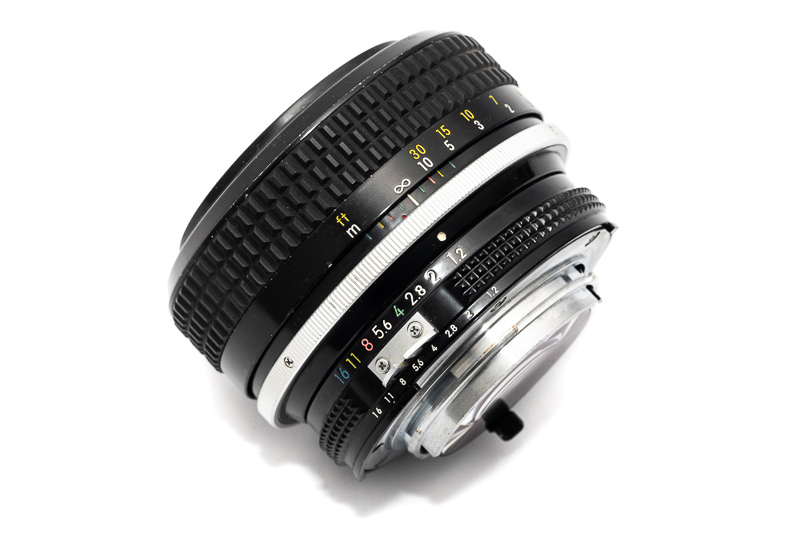
Ai and Ai-s lenses are fine. Generally you also don’t need to care about the differences between Ai and Ai-s.
I would stay away from pre-Ai lenses though, unless they have still been factory-converted to Ai by Nikon. The lenses with home-made conversions have no collector’s value at all and are therefore much harder to sell.
How to tell Ai(-s) and Pre-Ai lenses apart? The aperture ring needs to have small parts sticking out, like you see above between the smaller f/5.6 and f/8.0 markings, if it does, it is an Ai(-s) lens.

Nikon AF(-D) lenses with aperture ring are compatible to manual film cameras, AF film cameras and all the digital fullframe SLRs. They will not auto focus on Nikon Z cameras but they will on Sony E-mount cameras with the Monster LA-FE2 adapter.
AF(-D) lenses feature electronic contacts and a physical aperture ring like you see above.
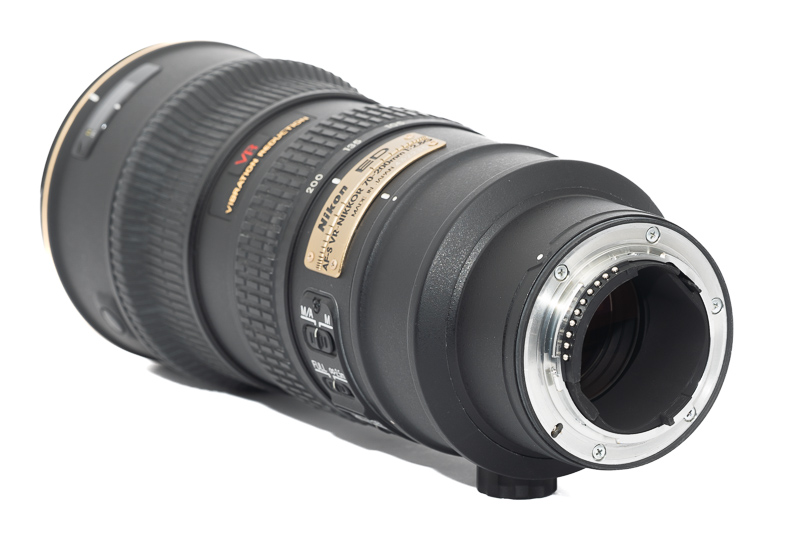
If you are not interested in the (mechanical) manual focus cameras and decide to go for one of the aforementioned later AF SLRs also the AF-S G (VR) lenses are a good choice. A huge benefit is that these can also be used without limitations on the Z-mount cameras via the FTZ adapter and also on Sony E-mount cameras with the Monster LA-FE1/2 adapters.
G lenses do not feature a physical aperture ring anymore, but there is still a small spring loaded lever (top right corner of the bayonet above) to mechanically control the aperture diaphragm.

Generally, if you want to use an analogue camera, you should stay away from the “E” lenses with electronic aperture diaphragm like the Nikon AF-S 28mm 1.4E or Nikon AF-S 105mm 1.4E and also the PC-E lenses, as you will not be able to change their aperture value.
E lenses look very similar to G lenses, but there is no more small lever for mechanically controlling the aperture diaphragm.
This should be ovbious but I will still mention it: you should also stay away from the DX crop-format lenses as their image circle is simply too small for 35mm film.
Last Words
In 2024 you can get a lot of high quality Nikon lenses from the past at affordable prices. Some of them are very versatile, as you can use them on mechanical film cameras, electronic AF film cameras, digital SLRs and also the latest mirrorless models.
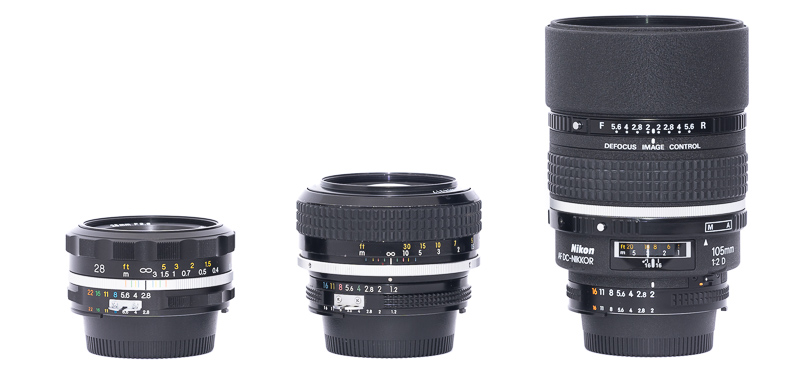
An FM2 is generally a more capable camera yet noticeably cheaper than a Leica M6, so if you want to delve into analogue photography with a mechanical camera today, I think an F-mount camera is a good choice – as long as you can find what you are looking for among the wide variety of F-mount lenses available.
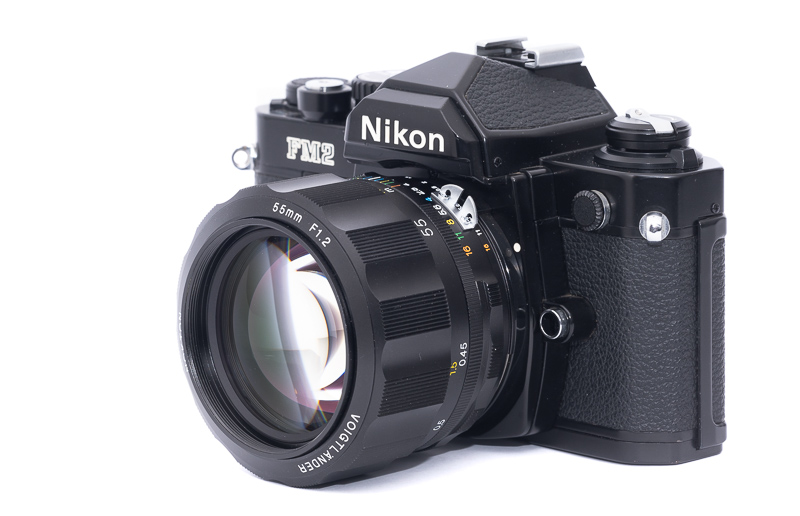
Further Reading
- Analogue Adventures Landing Page
- Review: Nikon AF-S 20mm 1.8G
- Review: Nikon AF-S 50mm 1.8G
- Review: Nikon AF-S 58mm 1.4G
- Review: Nikon Ai-s 50mm 1.4
- Review: Nikon Ai-s 180mm 2.8 ED
Support Us
Did you find this article useful or just liked reading it? Treat us to a coffee!
![]()
![]()
![]() via Paypal
via Paypal
This site contains affiliate links. If you make a purchase using any of the links marked as affiliate links, I may receive a small commission at no additional cost to you. This helps support the creation of future content.
Latest posts by BastianK (see all)
- Review: Sony FE 70-200mm 4.0 G Macro OSS II - December 20, 2025
- Review: Viltrox AF 35mm 1.2 FE LAB - December 17, 2025
- Analogue Adventures – Part 47: Tübingen - December 17, 2025
Bodies mentioned here have had a substantial price hike. Some cheaper options include
-Nikon F801 or F801s, semiprofessional bodies from early 90’s with an option for focusing screen with microprisms
-Nikon F90 and F90X
-Nikkormat FT3, last of the Nikkormats meters with AI-lenses
-Nikon FG, small package with program-mode and necessary bells and whistles
There is a reason they have not been mentioned, because they are not only cheaper, but also worse and offer less compatibility to different lenses.
I got the F801s for 40 euros. It has the same shutter as the newer fm2n, same high point viewfinder as the f3 and does matrix and point metering with cpu-lenses.
I paid an additional 30 euros for a focusing screen with microprisms and have been happy with it for three years now.
G-lenses only work wide open or in program mode tho.
The FG is more comparable to say Canon A1 though it doesn’t have shutter priority. It’s lighter and more compact than FM or FE-series but does have program mode and OTF-metering with dedicated flash units. OTF is pretty neat as I’m a terrible in estimating flash exposure with film.
So is saving 20€ worth not being able to use G and VR lenses? I don’t think so.
With the F80 not metering with non-cpu -lenses and F100 prices soaring at >250 euros I’d say it’s a pretty easy choice for me.
Are you shure about the shutter? FM2 has a mechanical shutter. I’m not shur if F 801 has that.
I used two 801 bodies and an FM2 for professional theatre and dance photography, back in the day. I wore out two FM2 bodies, as the shutter is rather fragile. But the two 801 bodies are still in my gear cupboard, battered and bruised, but still ready to go.
With compatible lenses, the 801, would be a great bargain for sombody starting out in analoghe.
While visiting my parents a few months, I found an F70 in a drawer and have been using it since, with a variety of films. Got a 50mm 1.4D (I hate kit zooms!) for it and it’s been a joy to use. The sticky rubber issue disappeared after a few days.
sticky coating can generally be removed with methylated spirits
I doubt you would like what the camera looks like u Der those coatings.
I did so with an F90X, it looks okay and the camera is fine without the rubber coating. But I prefer my Fm2n and FE2 above it.
The first FE and FM are compatible with pre-ai lenses via a small tab.
Damn that AF-D 85mm f1.4 looks nice on the F80!
Great article as usual. As others have pointed out there are some other alternatives as well, but you have picked the overall best option per category 🙂
I now own 4 F-mount film cameras:
F65: the F80 is better, but the F65 can still be found for basically no money. It’s also even lighter, which is nice when paired with some of the smaller AF-D lenses
F-301: fullfils the same role as an FE, but it has a better focusing screen (same one as the FM3a if I remember correctly). Looks like a mini F3.
FM: was cheaper than the FM2n and I can live without 1/4000s. The FT3 would be another alternative in this segment, but is bigger/heavier and has the shutter speed dial around the lens mount which I find a bit odd
F2 AS: fulfills the same role as an FM/FM2. It’s bigger/heavier but also much nicer made in my opinion (esp. the film advance is much smoother). Matches the Voigtländer 55mm f1.2 perfectly.
Nikon F4 is a great tank. With a P or K type focus screen, it can do manual focus great but it can also drive AF(D) lenses very well. Compared to F5 no G lenses but matrix metering is pretty good and works beautifully with any Zeiss zf2 etc lens 🙂
F5 on the other hand is too large
I can understand it not being recommended for compatibility but with analog, viewfinder experience is everything for me and since I used big lenses, F4 with a good focus screen made a lot of sense
I use my F4 also for street photography (I have F2 and a Olympus XA). I leave them more and more at home since i got the F4. It’s an amazing camera. I use it on aperture mode at f11 and focus at 4meters with my voigtlander 40mm Ultron. Everything is focus from 2m to 7m. I use HP5+ pushed to 1600 with matrix metering ON, all my shot are perfectly exposed, sharps, 3dish, etc… why not f100 or F5. f100 is expensive and F5 is… so big.
All this quibbling makes it almost seem more sensible to buy a Minolta; their huge range of manual-focus lenses remained physically compatible from the original SR-2 of 1958 to the very end, differing only in meter-coupling features. Still, I grant you that a Nikon grants more cachet among film-photography arrivistes…
The Nikon F-mount has been used more than 40 years longer than the SR mount. The range of Minolta lenses can definitely not be callsed “huge” compared to what you can find for the F-mount.
I’m curious how that tiny CV 28/2.8 performs!
Hello Bastian. May I ask why the F3 is not mentioned? OK, it is slightly larger and heavier than an FE, but everything about it is so high quality and smooth that an FM/FE feels almost like a tin can in direct comparison (of course I’m exaggerating). However, it is not an exaggeration to say that the viewfinder (or rather the focusing screen) of the F3 is clearly better than that of the FM/FE series, a waist-level viewfinder can be used (the light meter still works) and changing or cleaning the focusing screen is child’s play. I think there is a reason why the F3 is by far the Nikon that has been produced for the longest time. It’s best to have both. FM2 and F3. 🙂 Best wishes!
Siegfried
I am sure it is great, I just don’t see it being worth the asking prices on the used market.
I agree, the F3 is the best of the manual focus bodies. I have F2, F3 and had FM2n. In addition, the FM/FE series is ergonomically unpleasant for me, the cocking lever bothers me when looking into the viewfinder.
On eBay, the prices achieved for the F3 and FM2n are at about the same level. Considering that the F3 cost more than three times as much as an FM2n when new, I don’t think that’s too expensive. But many people are probably afraid of the electronics failing and are putting more trust in a mechanical FM2n. I admit that I can understand this thought! Personally, I would always choose the F3 over an FE.
Best wishes!
Siegfried
I wonder why Nikon was the only company to keep their SLR mount the same between film and digital. I feel like that is such an excellent feature that Canon missed out on, for example.
Because it allowed them to start clean with an all electronic mount whereas you need a degree to figure out what lens works on what body with Nikon: https://kenrockwell.com/nikon/compatibility-lens.htm
If you have (or want to use) pre-AI lenses, the FM is compatible. there is a little tab on the mount that pops down and makes it fit. With pre-AI lenses you have to use “stop down” metering, which means you push the stop-down lever (aka the depth of field preview) to force the lens from wide open to your chosen F stop–the image darkens and your metering becomes accurate. Release the lever to get a bright enough image to focus accurately. This particular camera lets you use lenses manufactured over more than five decades with no adapter.
The F75 is a small and light alternative with full compatibility…i use it with a battery grip for normal batteries…Think it is Nikons last F camera….it has mirror box..not prism = lighter.. An amazing little camera….Canon EOS 300 with battery grip is the Canon EF alternative…